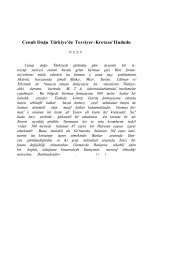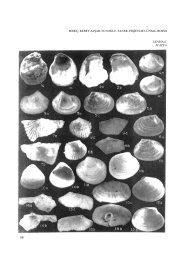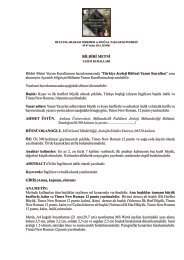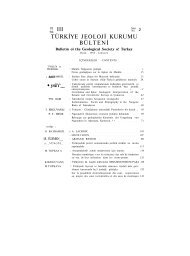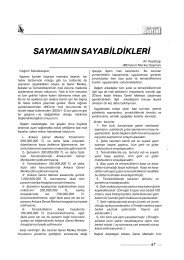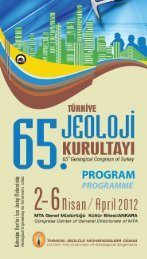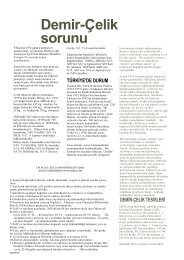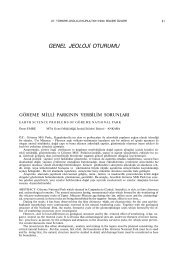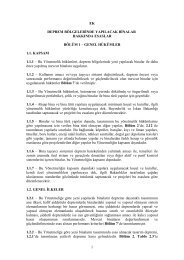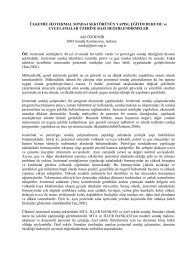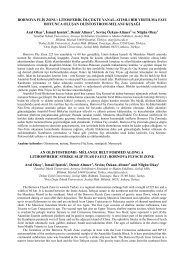öz - Jeoloji Mühendisleri Odası
öz - Jeoloji Mühendisleri Odası
öz - Jeoloji Mühendisleri Odası
Create successful ePaper yourself
Turn your PDF publications into a flip-book with our unique Google optimized e-Paper software.
gibi farklı iki derinlikte iki rezen/nar tespit edilebilmiştir. Sıcak su alınabilecek iki ayn lokasyon ve bir maden<br />
suyu bölgesi tesbit edilmiştir. Bu tespitlere göre birinci derecede önemli olandan mekanik sondajla 140 metre derinlikte<br />
55°C de 15 lt/snlik ve 15 metreye artezyen yapan sıcak su elde edilmiştir.<br />
Bütün bu çalışmalar, jeoelekfiik yöntemlerin (<strong>öz</strong>direnç, etkisel kutuplaşürma ve doğal gerilim) korelasyonu<br />
ile sıcak su aramalannın daha sağlıklı ve hızlı olarak başarılı bir şekilde yapılabileceğini ortaya koymuştur.<br />
it is well known that the tesistivity method is used.wideîy for underground water expioration. Whee some<br />
geological sîructııres with low resistivity give similar anomalies to those of stnıcttıres having water the sııcces<br />
of the resistivity method only can be limited.<br />
in önler to overcome this difficulty, the Induced poîarization method and the resistivity method have been<br />
applicated together for several area.-in the application, it is shown that the anomalies of the geological structures<br />
with the underground water have been obtained clearly by using suitable current and foequency band. it is also<br />
shown that clıaracteristics of anomalies differ depending on the properties of the acquifers such as sandy, conglomerale<br />
or karst media.<br />
Thus, current deesity and frequency dependence investigatioes oe the samples have been trited for expîoration.<br />
in different district, underground water with debbi from 15 lt/sec. to 70 lt/sec. colud be obtained from the<br />
purposed drill according to the results of this investigation.<br />
it is noted that. the tıse of the two methods together supplies a great easiness for solution of underground<br />
water problems, because of quantitative and qualitative interpretation.<br />
Up to now, Underground structure of Uşak-Banaz geothermal area could not be cleared sufficiently by several<br />
sectors because geological units have not outcrops to much.<br />
in order to determine a resevior, some geoelectric methods, such as resistivity, induced poîarization and<br />
şelf potential, area applied for the mentioned geothermal area having 10 krn-sq area.<br />
in this application, anomalies, wtıich is impossibîe to be götten by conventional work, could be obtained<br />
only by using soitable current density and frequency band because geological stratification has the repeatatıon of<br />
claystone, pebblestone and limestone with several thickness up to 600 meters depths. Structral and stratification<br />
of the mentioned area could be cleared and also the two reservoirs in depths of 150 meters and 600 meters could<br />
be determined by the interpretation of îhe improved anomalies from the horizontal and vertical geoelectric maps.<br />
The hot water in 55°C and of 15 lt/sec. has been obtained from the porposed drill. it has an artesian of 30<br />
meters.<br />
it is shown that this geothermic area, which can not be explained by geological studies, could be enlightened<br />
by the combination of te geophysical methods.<br />
* Akdeniz Üni. İsparta Müh. Fakültesi, <strong>Jeoloji</strong> Bölümü, İSPARTA<br />
37



